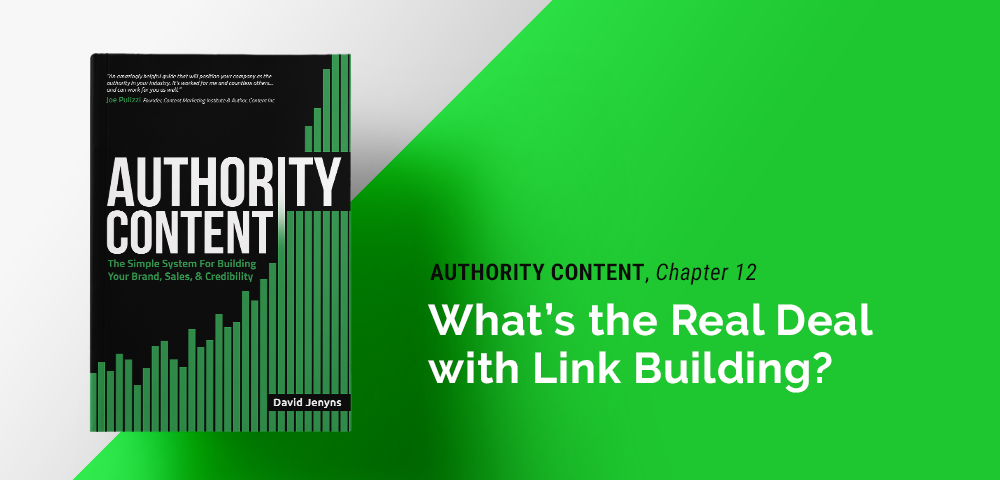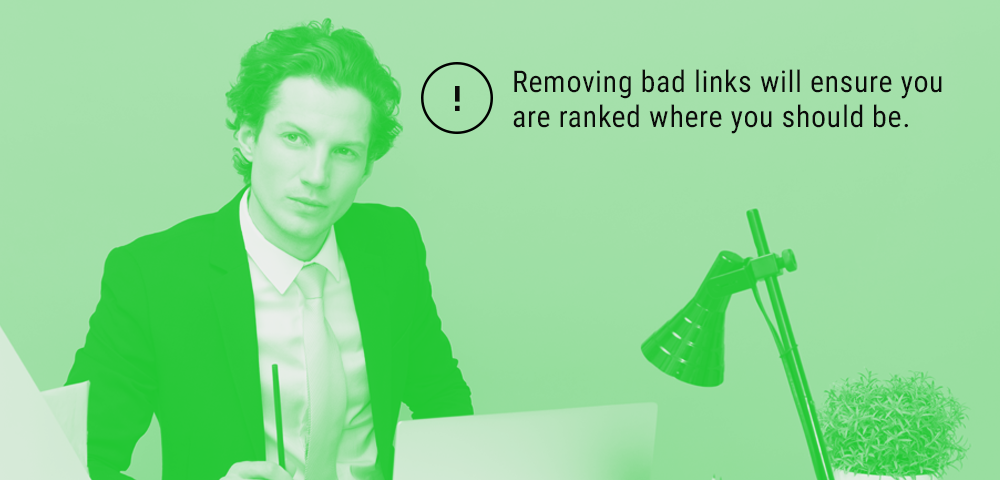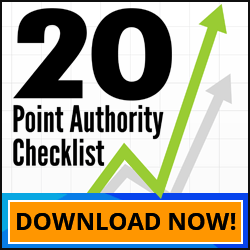If you are relatively new to the website world or find yourself slightly unskilled when it comes to SEO, you’ve probably been a bit confused about what link building really means.
Chapter index / Previous chapter / Next chapter
Old school SEO ‘experts’ will tell you one thing, another expert will tell you another, but all you really want to do is ensure that your site has the best chance of ranking as high as possible so you can see your sales grow.
Link building is still important for being recognised by Google as a reputable site, but like with many factors of SEO, the way to go out about it has changed from the early days. No longer do you need to even consider paying for backlinks from other dodgy sites, as there are ways to do your own backlinking that are free or low-cost – and won’t get your site into any trouble.
To learn more about this, it’s best we call on SEO expert David Jenyns, who wrote all about the correct linking techniques in his book Authority Content. We are delighted to share a chapter with you today, so let’s have a look!
CHAPTER 12: QUICK WIN INCOMING LINKS
With your usability and technicals all attended to, the third and final spoke in our website wheel is your incoming links.
Syndicating and sharing content – which is what we’re going to get into in the next chapter – will generate plenty of new links, but once again, there’s some preparatory work you need to put in place first.
In SEO circles, we used to talk about each incoming link representing a vote for your website and being the be all and end all of ranking. To a certain extent they’re still extremely important, but it’s been a very long time since merely getting more votes than the competition is enough to outrank them.
What’s required is to have your links “count” changed? Quality, diversity and relevance must now be the backbone of your link generation efforts.
Which of course, brings us back to the concept of creating links that serve the user above all else. You can still find places that offer to create hundreds of incoming links to your site for $5, but do you really believe that anyone’s getting any love from Google for that kind of practice?
The irony is that if SEO practitioners had always practiced quality, diversity and relevance in their link generation efforts, they could have maintained great search engine rankings consistently, through pretty much every Google update, without ever having to make any significant changes to their strategy.
There’s really no need to overthink this or get bogged down in the minute details of link anchor text, IP ranges and the velocity at which you build links. All you need to focus on is putting great content on relevant sites, spreading your efforts across a relatively broad range of locations and linking back to something relevant on your site.
Weed Out Problem Links
So, have you had any SEO work done on your site in the past? Before creating anything new, it’s sensible to review your existing links and attempt to remove any that could be flagged by Google as manipulative or spam.
If Google has already found something along these lines, you may have seen a notification in your Search Console account. As noted earlier, if you’ve received one of these, follow it up without delay and then take whatever action has been prescribed and follow through with a reconsideration request.
While it used to be possible to just drown out low quality, spammy links by generating a healthy volume of quality links, that’s no longer the case. Until you resolve the issue, your other rankings will suffer.
Note: Unfortunately, if you had great rankings before receiving a Google penalty, fixing the problem won’t instantly catapult you back up to the top. Chances are, that at least in part, your high ranking was a result of the “bad” links and your position was artificially inflated. Therefore, you’ll be returned to where Google believes you should have been ranking in the first place.
Don’t worry though, the Authority Content process will help you get back to where you were, but you need to be patient. Remember, this isn’t some push button solution.
I would also recommend, even if you don’t have any Google warnings, that it’s a good idea to be proactive. Google suggests webmasters review their link profile from within the Search Console and look for low quality links. Site-wide links, particularly from a low-quality site, are a problem waiting to happen and it’s worth addressing them now, rather than having to deal with them later as part of a reconsideration request.
In fact, if you’ve been building links for a while – months or even years – it could be worthwhile hiring a reputable SEO firm to perform a link audit and help you identify any parts of your link profile that are either hurting you or are likely to do so in the future.
Once you’re satisfied that your link profile is at least relatively clean, you can move on to creating some good quality links.
The Authority Content process will generate plenty of these good quality links over a period of months, but there are some quick wins worth getting. This is particularly valuable if your site is new and isn’t really on Google’s radar yet. You may already have some of these in place, so just work your way through and action any that are not.
Foundational Backlink Building
When thinking about backlink generation, start by thinking about your website.
Imagine your website’s homepage at the top, below that the main pages – which are usually one-click away from the homepage – and then below that, the deeper pages which might be product pages, your blog or other pages like that.
Next, identify all the pages that would be suitable landing pages for your visitors. In other words, if an individual page is the first thing a visitor sees on your site, would it make a good point from which they could start working their way through your site and learning about your products and services?
If the answer is “yes”, add this page to your list.
Now, when you have the opportunity to create a backlink, don’t automatically point it at your homepage, first look to see if there’s a more relevant page on your list that you can use instead.
As always, think user first and link second. The link description and the destination page should be relevant and interesting and not just thrown onto a random page for the sake of it.
Don’t obsess over anchor text when creating your links. That is, the words you use to link back to your website. Google isn’t as interested in this as it used to be and will know if you’re trying to create a volume of links all containing the same or very similar anchor text for the purposes of ranking. Use relevant keywords in your link, when you have the opportunity, but otherwise a brand term or simply your web address is fine.
Now, armed with your list of suitable backlink locations, let’s get you some easy wins.
Existing Contacts: Contact everyone in your business network, whether they’re a top-level client, an authority who attended your workshop, a supplier, distributor or anyone else connected to your business and ask them if they’d be willing to place a link on their website. It could be on a “Partners” page, a “Testimonials” page, a “Recommended Suppliers” page, or even at the end of a guest article.
Local (relevant) directories: Yes, directories are still important and will be for a long time to come! That doesn’t mean you should sign up to some mass auto-submission tool that posts your sites to 1,000’s of junkie, low quality directory sites. Identify the directories that are relevant to your industry and local area. Manually sign up to those and take the time to fill out the details correctly and in full. Directories such as Yelp or Yellow Pages (TrueLocal if you’re based in Australia) are good examples of sites in which you should feature.
Review Sites: This will be more relevant to some industries than others, for example – travel and restaurants, for example – but if a review site for your sector exists, try to tap into this, because it is essentially a link and testimonial opportunity, all rolled into one.
Register your business on appropriate review sites, and then as part of your process, chat with customers after they’ve purchased and invite them to post a review. Offering incentives to do this is fine as long as it’s clear that it’s NOT dependent on them leaving a positive review. Encourage honesty and welcome the occasional negative comment as an opportunity to improve your products or services.
Social Media: Aim to operate a minimum of two or three social platforms. These will become part of your content syndication. Facebook, Twitter, Google+ and maybe LinkedIn are the obvious candidates, but you should also consider platforms that are relevant to your industry. For example, is your target market on Instagram, Pinterest or even Snapchat? Go where your target market is and don’t just join a platform because it’s the current hot topic especially if you can’t maintain it!
This chapter from David Jenyn’s book provides some really valuable information surrounding how to build links in the right way. There’s no need to resort to dodgy techniques, just ensure you set your site up to be trustworthy and then get ready to be ranked appropriately.
If you learnt something from this chapter, we are sure that you will enjoy reading more from David’s book. While we are sharing a few different chapters on our blog, if you’d like to read it from start to finish you can head over to Authority Content or Amazon to get your copy today.







